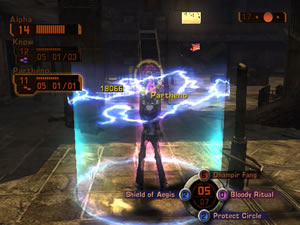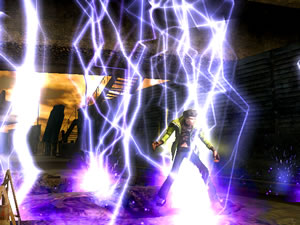From dust to must.
I find collectible card games downright frightening. I collected baseball cards as a wee nerdling, and although my collection was largely composed of the Detroit Tigers mid-relief pitching staff, I never lost a single game with them…for the simple reason that there were no “games” to play.
Some time after this, and after I grew out of idolizing the comic book guy at the hobby shop, collectible card games like Magic: The Gathering and Pokemon put a dizzying, impenetrable spin on collecting cards. I was, and still am, very wary. Besides, it’s impossible to take cutesy little monsters seriously when you already have boxes full of Garbage Pail Kids.
But before you dismiss Phantom Dust, self-billed a “card-game,” you should know that there are absolutely no cards in here at all. What Microsoft has made popular in Japan – and what Majesco has pleasantly brought to the U.S. – is a third-person fighting game utilizing the incredible depth of a card-game engine, without, thankfully, the cards. The result is a surprisingly fresh, fun game, and in this time of remakes and sequels, worth much more than its humble twenty dollar price tag. I, for one, expect to see fighting games based on Bridge or Pinochle in the future. “A three-trump combo from North? Go Fish, sucka!”
Phantom Dust is a difficult one to classify; its gameplay consists of a series of frenetic, short battles in various arenas, not unlike a fighting game. These battles are structured around an uncommonly detailed sci-fi plot. On top of that is the collectible “skill” element, which is why so many people compare it with those collectible card games that still frighten me.
In the single-player mode, you play as an anonymous character in a post-apocalyptic world. At some point in the recent past, everyone on earth mysteriously forgot everything, including their names (thus the anonymity). It turns out Earth is covered in a dust that inexplicably makes people forget, so civilization, scratching its head, moves underground. Sure, it might sound like the morning after your most recent Tequila Fanny Banger bender, but the story is explored for some surprising existential value. To finish it, your character will battle through over one hundred missions, which can take up to 20 hours depending on whether or not you take the time to read all of the dialogue and story-revealing “memory-boxes.”
The meat of the game lies in the missions, which take place on the surface and have you facing monsters with an arsenal of varied skills. Each character, including yourself, has a determined point in which the skills available to you will spawn as glowing orbs. Standing near each orb allows you to assign a skill to one of the face buttons. Once equipped, you can lock onto baddies using the right-trigger and exercise your destructive abilities.
Phantom Dust‘s immense variety of skills creates some terrific strategic potential. Attack skills include, for example, basic firebolts, arcing grenade weapons, crawling attacks that course through the floor, rain attacks that shower the opponent with the element of your choice, and a plethora of melee, sword and kick attacks. Defensive skills are just as varied, ranging from shell-like shields to flaming barriers to erasing fields that cancel your opponents’ skills.
Each skill type works to different degrees according to your opponent’s choice of skills. For example, an “about face” defense will hurl back any grenade-type attack, but will be powerless against a rain-type attack. With the addition of status skills (which enhance your attributes), environment skills (which affect everyone on the board), and special skills, the sheer number and incredible variety of attacks and defenses ensures that no two strategies will be alike.
 Here’s where the card thing enters the fray. By building and refining deck-like “arsenals,” you can determine which skills spawn in your battle. To guarantee a good mix, the game assigns each skill to a separate “school.” Since the arsenals you create can only contain cards from two schools, your playing style will be determined by which two schools you choose. Some schools, like the Optics school, do well at long-range, while others, such as the martial-arts oriented Ki school, are optimal at close-range. Other schools focus on erasing opponent’s skills, suicidal attacks that damage oneself as well as the enemy, and attacking opponents’ orbs directly.
Here’s where the card thing enters the fray. By building and refining deck-like “arsenals,” you can determine which skills spawn in your battle. To guarantee a good mix, the game assigns each skill to a separate “school.” Since the arsenals you create can only contain cards from two schools, your playing style will be determined by which two schools you choose. Some schools, like the Optics school, do well at long-range, while others, such as the martial-arts oriented Ki school, are optimal at close-range. Other schools focus on erasing opponent’s skills, suicidal attacks that damage oneself as well as the enemy, and attacking opponents’ orbs directly.
To build a good arsenal, you need to pass missions and buy skills from the local vendor (who reminds me a lot of the ubiquitous comic book guy). Each arsenal has a limited number of slots, a good deal of which must be assigned to “aura particles,” rechargeable energy units that the game uses as ammunition. It’s a good thing that you don’t necessarily have to fiddle with your arsenal too often, since the store, arsenal lab, and the mission center are all a load screen away from each other – so close and yet so far.
It’s in the subterranean mission center that Phantom Dust‘s most distinct flaw becomes apparent. All of the story-telling and mission-giving takes place underground. You talk to the inhabitants and they give you missions while telling you what they remember of their life stories. Unfortunately, some missions are character specific, but the game gives no hints as to whose mission you have to complete next, meaning you will have to wander and talk to the same twelve people over and over throughout the entire game. Guess all the cell phones got wiped out in the apocalypse.
But ultimately, the single-player mode is not why you will keep coming back to Phantom Dust. After building up a decent arsenal in the single-player game, you will want to take your skills online. Finding games is easy, and settings that allow you to restrict your rivals’ ranks will ensure you’re always in an optimal match for your level. Skills can be traded, bought, or even bet online. Also, new skill updates are periodically available for download through Xbox Live. That’s a whole deck of replay value right there.
 The animators have distorted the residents of the Phantom Dust world just enough to be scary, but not enough to be cute. The player character, for example, sports skin-tight leopard pants, big white hair, and weighs in at 50 pounds of pure bone. He looks like the fruit of an unholy union between Mick Jagger and David Bowie, with Steven Tyler looking on as a distant uncle.
The animators have distorted the residents of the Phantom Dust world just enough to be scary, but not enough to be cute. The player character, for example, sports skin-tight leopard pants, big white hair, and weighs in at 50 pounds of pure bone. He looks like the fruit of an unholy union between Mick Jagger and David Bowie, with Steven Tyler looking on as a distant uncle.
Unfortunately, voice work is missing from much of the game but the music is refreshingly smart. Most of the ambient tracks are haunting renditions of classical favorites, such as Beethoven’s Moonlight Sonata. Given that the story concerns the recovery of forgotten memory, the soundtrack fits perfectly.
But Phantom Dust need not make any apologies for its graphics, which are superb. The post-apocalyptic environments are beautifully gritty, and each of the over thee hundred skills has its own unique and colorful animation. The environmental designs, while only seven in number, are well balanced between long-range sniper battles and claustrophobic urban melees. Everything is interactive: walls explode, ceilings collapse, and chairs and tables can be hurled at enemies. Blowing up a ceiling under which an opponent is hiding, for example, will incur a lot of damage and a good amount of online cursing.
The interaction between Phantom Dust‘s long single-player game, in which you build up your arsenal, and the multiplayer game, in which you use it, is very satisfying. Its storytelling frame is cumbersome, but its bargain price belies incredibly deep gameplay and a rich plot. You can forget your phone number, your parents, and even your birthday, but if you own an Xbox, don’t forget to check out this game.
-
Unique battle scheme
-
Interactive environments
-
Complete online/offline package
-
Cheaper than a tank of gas
-
Rift between action and plot
-
Significant load times
-
Only seven environments











